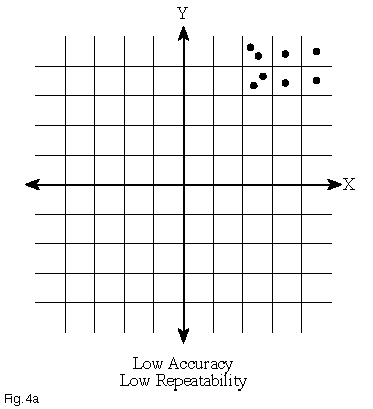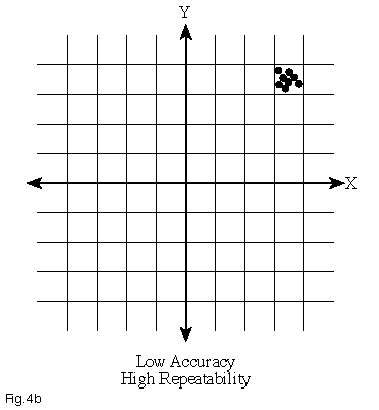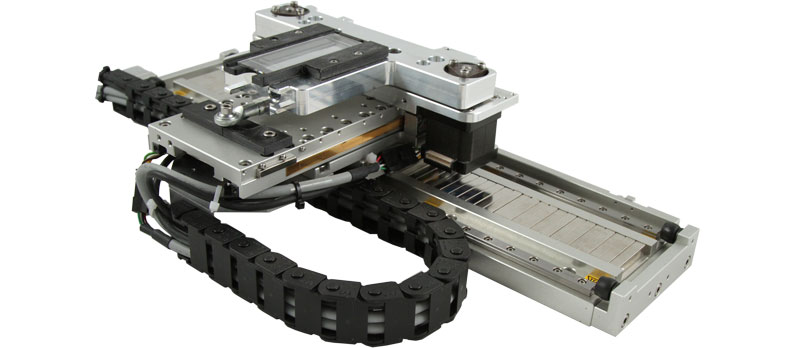Repeatability
The repeatability of a positioning system is the extent to which successive attempts to move to a specific location vary in position.
A highly repeatable system (which may or may not also be accurate) exhibits very low scatter in repeated moves to a given position, regardless of the direction from which the point was approached. Figures 4a, b, and c illustrate the difference between repeatability and accuracy.



A distinction can be drawn between the variance in moves to a point made from the same direction (uni-directional repeatability) and moves to a point from opposing directions (bi-directional repeatability). In general, the positional variance for bi-directional moves is higher than that for uni-directional moves. Quoting uni-directional repeatability figures alone can mask dramatic amounts of backlash.
Our repeatability testing is performed in the following sequence: the table is indexed to a point from one direction (say, from -10 mm to 0.000 mm). The measuring instrument (typically a laser interferometer) is then “zeroed”. The table then continues in the same direction to +10 mm, returns to 0.000 mm, and continues on to -10 mm. The move sequence is then repeated for 5 cycles, with positional data acquired at each approach to “zero”. Approaches to zero alternately display the uni-directional and bi-directional values, and the worst case deviations are recorded as the respective repeatabilities. There is a natural tendency to want to collect data from a large number of cycles, and statistically process these to prepare a 3 sigma value of repeatability. While this can be done to characterize closed loop positioning systems using a linear feedback sensor, repetitive move sequences with open loop, interpolated, or rotary encoded stages tend to generate some frictionally induced leadscrew heating, with consequent thermal expansion and positional drift. Accordingly, any of this catalog’s repeatability figures for standard positioning tables (as opposed to complete servo systems) reflect the specific properties of the leadscrew and nut. Thermal expansion is very dependent on operating speed and duty cycle. The short-term nature of the repeatability test also eliminates any influence due to ambient temperature changes.
 The degree of concern displayed above to eliminate thermal effects from the measurement of repeatability may seem overly exacting; it is driven, however, by the desire to properly showcase the very high intrinsic repeatability of our anti-backlash nut design (used with leadscrew-driven stages). Extensive testing with a laser interferometer reveals typical uni-directional values of below 0.5 micron (with many in the 0.1 to 0.3 micron range), and bi-directional values below one micron (with many in the 0.2 to 0.5 micron range). In addition, the self-compensating nature of the anti-backlash nut design results in little degradation of these values over service lifetimes in excess of 5 million meters.
The degree of concern displayed above to eliminate thermal effects from the measurement of repeatability may seem overly exacting; it is driven, however, by the desire to properly showcase the very high intrinsic repeatability of our anti-backlash nut design (used with leadscrew-driven stages). Extensive testing with a laser interferometer reveals typical uni-directional values of below 0.5 micron (with many in the 0.1 to 0.3 micron range), and bi-directional values below one micron (with many in the 0.2 to 0.5 micron range). In addition, the self-compensating nature of the anti-backlash nut design results in little degradation of these values over service lifetimes in excess of 5 million meters.
When a very high level of repeatability is required, it is better to dispense with the use of leadscrews altogether, and substitute a linear motor as the actuating element. While this requires the addition of a linear encoder, and operation of the stage in closed loop mode with a servo controller, the resulting performance is greatly enhanced, and is limited only by the resolution of the linear encoder and the inevitable presence of thermal effects.

